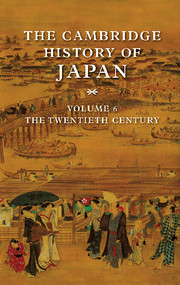Book contents
- Frontmatter
- 1 Introduction
- PART I DOMESTIC POLITICS
- PART II EXTERNAL RELATIONS
- PART III ECONOMIC DEVELOPMENT
- Part IV SOCIAL AND INTELLECTUAL CHANGE
- 11 The transformation of rural society, 1900–1950
- 12 Economic development, labor markets, and industrial relations in Japan, 1905–1955
- 13 Socialism, liberalism, and Marxism, 1901–1931
- 14 Japanese revolt against the West: political and cultural criticism in the twentieth century
- Works Cited
- Index
- References
12 - Economic development, labor markets, and industrial relations in Japan, 1905–1955
from Part IV - SOCIAL AND INTELLECTUAL CHANGE
Published online by Cambridge University Press: 28 March 2008
- Frontmatter
- 1 Introduction
- PART I DOMESTIC POLITICS
- PART II EXTERNAL RELATIONS
- PART III ECONOMIC DEVELOPMENT
- Part IV SOCIAL AND INTELLECTUAL CHANGE
- 11 The transformation of rural society, 1900–1950
- 12 Economic development, labor markets, and industrial relations in Japan, 1905–1955
- 13 Socialism, liberalism, and Marxism, 1901–1931
- 14 Japanese revolt against the West: political and cultural criticism in the twentieth century
- Works Cited
- Index
- References
Summary
INTRODUCTION
Japan's “first industrial revolution,” led by the textile industries (cotton spinning, silk reeling, and fabrics), had lost momentum by about 1910. The outbreak of World War I, however, thrust Japan into the position of supplying the warring nations of Europe with war matériel and supplying the markets of Asia with consumer manufactures. As a result, the Japanese economy began to move toward a “second industrial revolution” with the sudden growth in heavy industries such as metal working, machines and equipment, and shipbuilding. But the economy could not absorb the output of this sector once the overseas demand decreased. When peace was restored and production resumed in Europe, the Japanese economy was forced into a period of retrenchment and reorganization. During a series of adjustments in the 1920s, the economy slowed down its development toward an advanced industrial structure. When this second industrial revolution finally arrived in the 1930s, the leading industries were those heavy industries geared to the requirements of war and imperial expansion overseas. With Japan's defeat in World War II, it was forced back to its prewar economic level, from which it recovered by about 1952 to the “normal” level of the 1930s. By 1955, economic forces and institutional arrangements were well in place to launch a new era in Japanese economic history.
During this half-century of steady but uneven growth, manufacturing plants employing a large number of workers played a central role. Employment management in these large enterprises evolved in many directions different from those of other advanced modern capitalist economies.
- Type
- Chapter
- Information
- The Cambridge History of Japan , pp. 606 - 653Publisher: Cambridge University PressPrint publication year: 1989
References
- 3
- Cited by



